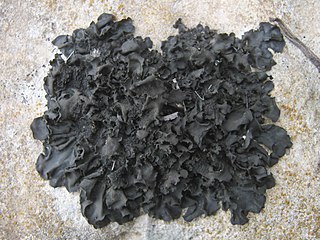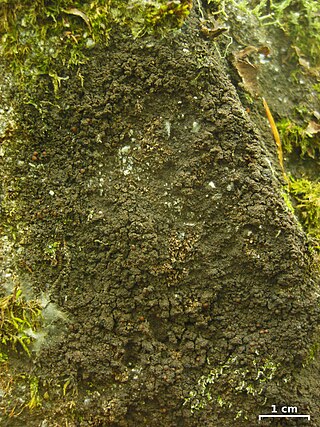
Collema is a genus of lichens in the family Collemataceae. The photobiont is the cyanobacterium genus Nostoc. Species in this genus typically grow on nutrient-rich bark or somewhat siliceous or calcareous rocks in humid environments.

The Pannariaceae are a family of lichens in the order Peltigerales. Species from this family have a widespread distribution, but are especially prevalent in southern temperate regions.

The Collemataceae are a lichenized family of fungi in the order Peltigerales. The family contains ten genera and about 325 species. The family has a widespread distribution.

Pseudephebe is a genus of fruticose lichens in the family Parmeliaceae. It contains three species that grow on rocks.

Placomaronea is a genus of lichenized fungi in the family Candelariaceae. It has 6 species. The genus was circumscribed by Finnish lichenologist Veli Räsänen in 1944, with Placomaronea candelarioides assigned as the type species. The genus was revised by Martin Westberg and colleagues in 2009, who accepted six species in the genus.

Leptogium is a genus of lichen-forming fungi in the family Collemataceae. It has about 110 species. Species formerly classified under Leptogium have since been divided among the genera Leptogium, Pseudoleptogium, and Scytinium. Leptogium lichens are predominantly found on tree bark or soil, often among mosses, and sometimes on rocks in moist environments.
Leciophysma is a genus of cyanolichens in the family Pannariaceae. It has four species. The genus was circumscribed by Theodor Magnus Fries in 1865, with Leciophysma finmarkicum assigned as the type species.
Arctomia is a genus of lichen-forming fungi in the family Arctomiaceae. The genus was originally circumscribed by Theodor Magnus Fries in 1861. Arctomia has a circumpolar distribution.

Vahliella is a genus of nine species of lichen-forming fungi in the order Peltigerales. It is the only member of Vahliellaceae, a family circumscribed in 2010 to contain this genus. Vahliella was formerly placed in the family Pannariaceae until molecular phylogenetics showed that it did not belong there. Vahliella species are found in the Northern Hemisphere – mainly in North America, but also in Europe and India.

Blennothallia is a genus of jelly lichens in the family Collemataceae. It has four species, which collectively have a cosmopolitan distribution.

Enchylium is a genus of fungi belonging to the family Collemataceae. The genus has a cosmopolitan distribution.

Scytinium is a genus of lichen-forming fungi in the family Collemataceae. It has 49 species. These lichens are typically found on basic rocks, soil, and trees, occasionally in association with mosses. Despite the morphological and ecological diversity within Scytinium, its species share similar ascospore features, such as shape and septation, as well as a small to medium-sized thallus with at least a partial cortex.

Lathagrium is a genus of lichen-forming fungi in the family Collemataceae. It has 10 species of gelatinous lichens. Species in this genus typically grow on calcareous rocks, often amidst mosses, but can also be found on siliceous or serpentine rocks, mortar, or soil.

Lepidocollema marianum is a species of cyanolichen in the family Pannariaceae. It was first scientifically described by Elias Fries in 1825 as Parmelia mariana. Per Magnus Jørgensen transferred it to the genus Lepidocollema in 2014 following a molecular phylogenetics-guided revision of the Pannariaceae.
Nevesia is a monotypic genus of lichenized fungus in the family Pannariaceae. It contains the species Nevesia sampaiana. The genus name honors Carlos das Neves Tavares, the Portuguese lichenologist who first identified the species in 1950.

The Collematineae are an suborder of rust fungi in the order of Peltigerales in the class Lecanoromycetes.
Leptogium adnatum is a species of lichen in the family Collemataceae. Found in Cape Horn, the southernmost point of South America, it was formally described as a new species in 2013 by Norwegian lichenologist Per Magnus Jørgensen. The crust-like thallus of the lichen comprises densely packed, intricately folded, irregular squamules that in some parts form dark greyish-blue lobes that are firmly attached to their rock substrate. The species epithet adnatum refers to this tight attachment. Leptogium adnatum is only known to occur on coastal rocks in the Cape Horn region. The coastal locale is unusual for a species of Leptogium, but the author speculates that the high levels of rainfall that occur in the area dilutes the salt concentration sufficiently to make the climate more amenable to the growth of the lichen.
Leptogium auriculatum is a species of foliose lichen in the family Collemataceae. Found in Cape Horn, the southernmost point of South America, it was formally described as a new species in 2013 by Norwegian lichenologist Per Magnus Jørgensen. The type specimen was collected by William R. Buck east of Puerto Williams, where it was found growing on wet rocks along a small stream in a disturbed Nothofagus forest. The leafy thallus of the lichen comprises orbicular, sometimes overlapping lobes, packed, intricately folded, irregular squamules that in some parts form dark greyish-blue lobes with undulating margins and a width of 0.5–1 cm (0.2–0.4 in). The upper thallus surface is more or less smooth, shiny, and dark greyish-brown, while the undersurface is paler and smooth. Leptogium auriculatum is only known to occur on rocks in the Cape Horn region in a couple of difficult-to-access locations.

Hondaria is a single-species fungal genus in the family Collemataceae. It contains the species Hondaria leptospora, a corticolous (bark-dwelling), foliose lichen. This lichen was previously classified under the genus Collema, and later Arctomia, but molecular research combined with morphological analysis indicates that it forms a distinct genus. Named in honour of Dr. Neli Kika Honda, a researcher of lichen chemistry, Hondaria leptospora is notable for its long, thin, transversely-septate ascospores, the longest within its family. The species is found predominantly in the west-central regions of Brazil near the borders with Bolivia and Paraguay.
Placomaronea kaernefeltii is a rare species of saxicolous (rock-dwelling) lichen in the family Candelariaceae. Found in South America, it was formally described as a new species in 2009 by lichenologists Martin Westberg, Patrik Frödén, and Mats Wedin. The type specimen was collected by the second author from Arica (Chile), between Socoroma and Putre, at an altitude of 3,750 m (12,300 ft), where it was found growing along cracks and pits on a siliceous boulder in a dry mountain slope. The lichen is only known to occur at its type locality, although the authors suggest a wider distribution is likely. The species epithet honours Swedish lichenologist Ingvar Kärnefelt.















